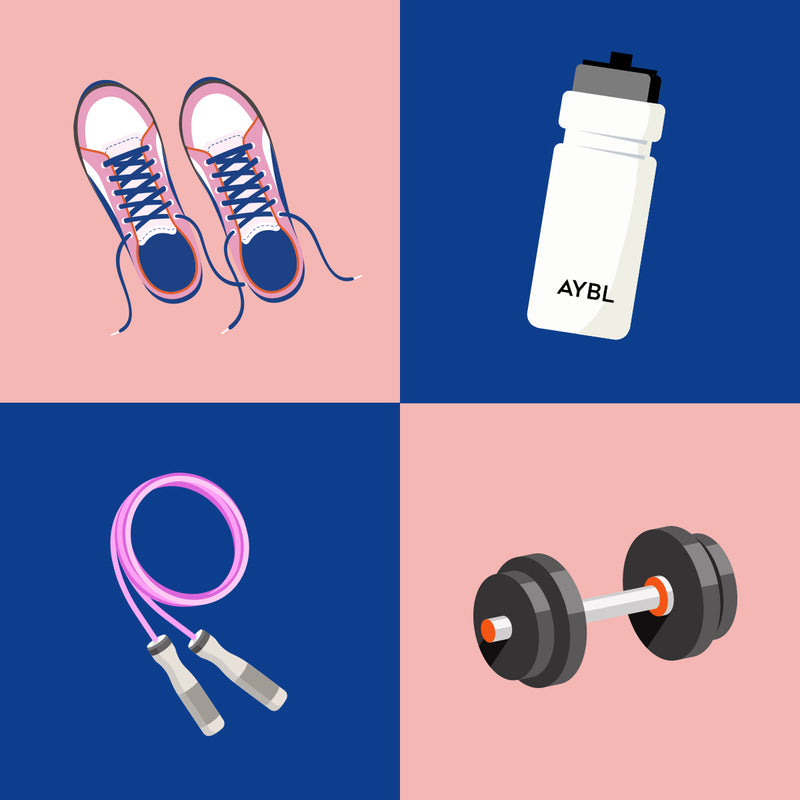
Gym Acronyms & Abbreviations Explained
Working out is challenging enough without having to learn a million and one acronyms and with so many terms being thrown around, it can often feel like a whole different language.
Which is why we’ve taken it upon ourselves to do the hard work, so you don’t have to.
From PBs to AMRAP, our complete guide to some of the most common fitness acronyms is designed to help you get up to speed, so you can continue to smash your goals without any obstacles.

GYM ACRONYMS
PB (Personal Best) or PR (Personal Record):
This is used to track your top performance. For example, it could refer to the highest number of reps of an exercise, heaviest weight lifted or fastest time to run a certain distance.
WOD (Workout Of the Day):
A term used in CrossFit for the style of workout that is to be completed during a session. This usually varies day-to-day.
DOMS (Delayed Onset Muscle Soreness):
This refers to the muscle pain and stiffness that you experience a day or two after you workout. This is said to be a result of tiny, microscopic tears in your muscle fibres which trigger inflammation.
ROM (Range Of Motion):
ROM is the capability of a joint or muscle to go through its complete spectrum of movement, for example, how far you can move or stretch it.

TRAINING STYLES
AMRAP (As Many Reps As Possible):
AMRAP is used during workouts when the goal is to do as much of something in a given timeframe. This could be the number of reps of a particular exercise or the number of sets for a collection of exercises, completed back-to-back with as little rest as possible.
EMOM (Every Minute On the Minute):
EMOM is a form of interval training which requires you to complete a certain number of reps of a particular exercise within 60 seconds. Once you complete the round, you use the time left to rest before your next set, which will commence on the minute.
HIIT (High-Intensity Interval Training):
HIIT entails short bursts of intense exercise, such as 30 seconds of high knees with a pause, performed at maximum capability, followed by periods of rest.
LISS (Low-Intensity Steady-State):
LISS is a type of cardiovascular exercise which focuses on aerobic activity at a low-to-moderate intensity for an extended time period. This could include walking, swimming or steady cycling.
EDT (Escalating Density Training):
EDT is a hypertrophy training technique used to build big muscles. The aim is to perform as many reps as possible (or should we say, AMRAP?) in a given time, using antagonistic exercises, which work opposing muscle groups.
SS (Superset):
A superset is a form of strength training whereby you move quickly from one exercise to another without taking a break in between.
RDL (Romanian Deadlift):
The Romanian Deadlift is a traditional barbell lift used to build the strength of the posterior chain muscles, including the gluteus maximus. When performed correctly, the RDL can effectively help to strengthen the core and lower body with one move.
Push Day:
A push day workout consists of upper body exercises that focus on using a pushing motion, such as an overhead shoulder press, tricep dips and dumbbell lateral raises. These exercises primarily target the chest, shoulders and triceps.
Pull Day:
A pull day workout works in the opposite way to a push day workout, utilising, as the name suggests, a pull motion. Types of pull exercises include: dumbbell bicep curls, lat pulldowns and barbell rows. A pull day workout focuses on engaging the biceps, forearms and back muscles.

GYM EQUIPMENT ACRONYMS
KB (Kettlebell):
A kettlebell looks like a cast-iron cannonball with a handle on top. They come in various weights and can be used to enhance exercises, such as lunges and squats.
DB (Dumbbell):
A dumbbell is a short bar with weights on either side and is typically used during upper body workouts to strengthen the arm and shoulder muscles.
BB (Barbell):
A barbell is a metal bar that can be loaded with weights for strength training. Unlike a dumbbell, a barbell requires two hands and is a more effective piece of equipment for heavy lifting.

HEALTH INDICATORS
BMI (Body Mass Index):
BMI is the ratio of your weight to height. It can be used to measure your health, but it is important to keep in mind that it does not take into consideration your body fat percentage or body fat distribution.
BMR (Basal Metabolic Rate):
BMR refers to the total number of calories you burn on a daily basis when your body is resting.
TDEE (Total Daily Energy Expenditure):
Your TDEE is the total number of calories you burn during a 24-hour period, taking into account all movement and exercise. This can be used to influence your weight management plans, for example, for weight loss or muscle gain.

Phew… Aren’t you glad we decoded all of those fitness acronyms? It’s safe to say, there’s a lot to learn.
But thanks to us, there’s no need to memorise them all. Just allow yourself to focus on what matters most to you and we’ll sort the rest. You can thank us later.